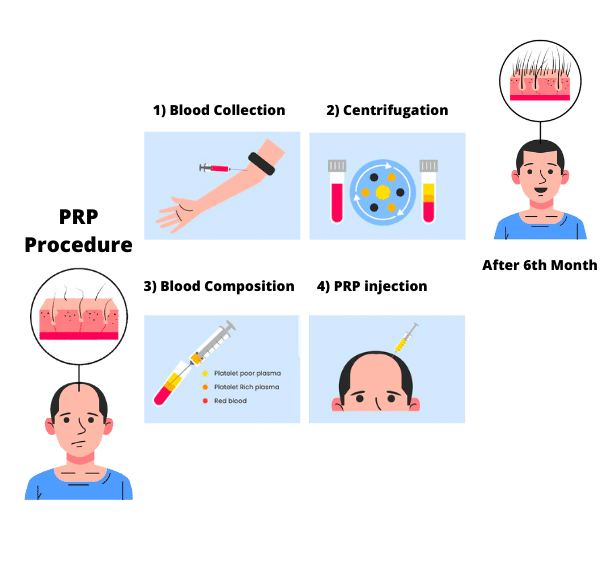- Persian: (+90 507 138 03 03). English: (+90 507 015 06 03)
The PRP (Platelet-Rich Plasma) method employs the reconstructive and regenerative ingredients necessary for our skin to thrive and for speedier recovery. PRP is used to help the body mend itself after a variety of surgical procedures, and it is now commonly used in aesthetic surgery. In addition to treating scars, wounds, cracked or damaged skin, it also promotes hair development.
Due to this, PRP now plays a significant part in hair loss therapies. After the transplant has been done, PRP is applied to the regions most in need of regeneration and stimulation. PRP is used to aid in the healing of afflicted regions, promote hair development in those places, and revive thinning hair.

Platelets are blood cells having several functions throughout the body.
– One function is to increase blood clotting so that a patient does not bleed heavily when cut.
– The blood also have proteins that promote wound healing.
– Researchers hypothesize that by injecting large quantities of platelets into regions of inflammation or damaged tissue, it is possible to promote wound healing.
A little blood sample is extracted from the patient and placed in a spinner or other equipment that spins at a fast rate. This procedure separates platelets from other components of the blood. The platelet concentration is then injected into the part of the patient’s body that requires treatment.
Doctors believe that the injection’s high concentration of platelets, which may be five to ten times that of untreated blood, would accelerate the healing process.
The following are examples of treatment locations where PRP has been used:
As a means of lowering the inflammation that may cause hair loss, doctors have injected PRP into the scalp.
Initially, PRP was utilized to promote healing after jaw and plastic surgery. Examples of tissues that have been treated with PRP include:
Ligaments may be slow and difficult to mend, making PRP an appealing alternative for certain individuals who have sustained injuries to this tissue category.
Doctors have employed PRP to treat osteoarthritis-related inflammation. This inflammation might result in painful and stiff joints.
In general, there are minimal processes involved in preparation for PRP injections.
Nevertheless, PRP may be administered in several methods. For instance, a topical lidocaine solution is sometimes administered on the scalp prior to injection. For this to be administered, you may need to come early to your treatment appointment.
Occasionally, a topical anesthetic is used with PRP to ease pain. Occasionally, your doctor may inject or apply PRP during surgical procedures. In this situation, preparing for PRP injections would require following to your surgeon’s pre-surgery instructions.
A tube (10 ml) of the patient’s blood is extracted and processed for about 15/20 minutes.
It takes minutes to extract platelets and growth factors from other components in a blood sample.
The normal PRP injection procedure is as follows:
A medical expert will get a blood sample from you. The quantity of sample required depends on the injection site. For example, 20 milliliters of blood was injected into the scalp for one trial using a reliable source. This is a little more than one teaspoon.
Blood is centrifuged in a centrifuge. This is a machine with a rapid rotation that separates blood components. The separating procedure lasts around 15 minutes.
The separated plasma is prepared for injection into the afflicted region by a technician.
In order to target precise injection sites, such as the tendon, doctors often employ imaging techniques such as ultrasonography. The PRP will then be injected into the afflicted region by your doctor.

Due to the fact that PRP entails inserting a substance into the skin, adverse effects are possible. PRP is autologous, meaning it includes components derived directly from the patient’s own body. This minimizes the likelihood of an adverse response resulting from the injection of other drugs, such as cortisone or hyaluronic acid. However, there are hazards associated with the injection itself, such as:
– Infectious nerve damage
– Discomfort at the injection location damage to the tissue
You should discuss these possible dangers with your doctor, as well as the efforts he or she will take to reduce them.
When PRP is injected after an accident, your doctor may advise you to relax the damaged region. However, these suggestions pertain more to the injury than to the PRP injections. Following PRP injections, the majority of patients are able to resume their normal activities.
For 48 hours, the patient should refrain from bathing the treated region. After that, it is OK to continue using hair and skin care products and topical drugs.
As PRP injections are meant to stimulate healing or development, you may not see a change immediately after treatment. However, after a few weeks or months, you may notice that the treated region heals quicker or grows more hair than you would have anticipated if you had not gotten PRP injections.
The treatment region may be uncomfortable for two or three days, and bruising may occur. Acetaminophen may help alleviate pain. In the event of acute discomfort, the patient should immediately contact the doctor’s office.
One week following PRP therapy, hair coloring and coloring procedures may continue.
